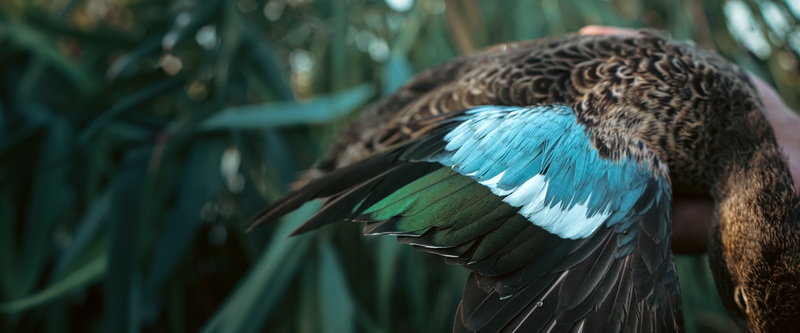Decoding HIP: A Guide to the Harvest Information Program
A full breakdown of this essential certification in migratory bird conservation.
by Nathan Ratchford

The hunting season is here. Whether rushing to your local sporting goods store or going online, purchasing a hunting license is one of the most important and exciting first steps for getting afield. But if you are a waterfowl hunter like me, you need to answer a few questions. But what exactly is the purpose of these questions and how do they play a role in migratory bird management?
HIP, or the Harvest Information Program, is cooperatively managed by the U.S. Fish and Wildlife Service (USFWS) and state fish and wildlife agencies. Put simply, it requires waterfowl and other migratory bird hunters in 49 states (migratory bird hunting is not permitted in Hawaii) to get their HIP certification by answering a few questions about past harvest patterns. HIP certification is typically obtained when purchasing an annual hunting license, but even hunters with a lifetime license are required to complete the certification.
Information collected during HIP certification is later used to create a sampling framework for the annual U.S. Fish and Wildlife Service Migratory Bird Harvest Survey (diary survey) and Parts Collection Survey (wing survey). These surveys, in conjunction with band recoveries and population surveys, provide the three primary data sources that migratory bird managers rely on to make informed decisions about hunting regulations and population management.
Who Needs HIP Certification?
HIP certification is legally required for any hunter intending to harvest migratory birds, including species such as ducks, geese, swans, doves, cranes, rails, gallinules, moorhens, woodcock, snipe and yes, even coots. Note, however, that many states exempt hunters under a certain age from HIP certification. Make sure to check your state-specific regulations for details.
It’s important to note that hunters must get HIP certification in every state in which he or she plans to hunt waterfowl and other migratory birds. Importantly, HIP questions should be answered relative to hunting experiences in the particular state for which certification is obtained. Hunters not planning to hunt migratory birds during a given year should not register for HIP, as incorrect registration can adversely affect the accuracy of hunter and harvest estimates.
Importance of Participation
HIP certification is not only a legal requirement but also a critical component of migratory bird management. Data collected through HIP help biologists estimate migratory bird populations and assess the impact of hunting. Accurate harvest estimates are vital for:
Ensuring the health and sustainability of migratory bird populations
Setting appropriate hunting regulations
Maintaining future hunting opportunities
“Hunters directly benefit from participating in HIP and the harvest surveys because their data is used to assess the health of migratory bird populations. This data provided by hunters in turn makes a meaningful contribution to ensure future hunting seasons,” said HIP Coordinator at the Wildlife Management Institute, Brad Bortner. Bortner retired as Chief of the USFWS Division of Migratory Bird Management after 33 years at FWS in 2017.

Hunter Participation
Contrary to popular belief, the answers you provide during HIP certification do not directly determine annual estimates of harvest. Instead, HIP is just the first in a three-component process for estimating annual migratory bird harvest and hunter numbers. Answers to HIP questions are used to sort hunters into 3 groups based on past migratory bird hunting success, under the assumption that harvest in the previous year is a decent predictor of expected harvest in the current year.
The three components of annual Harvest Surveys that are cooperatively conducted by USFWS and state fish and wildlife agencies include the following:
HIP Certification: Hunters provide information about their previous year’s hunting activities. These data are used to sort hunters into groups based on harvest patterns.
Diary Survey: Through fall and winter, state agencies submit the contact information of HIP-certified hunters to the USFWS. From this pool, a random sample of hunters is selected to participate in the Diary Survey. These hunters receive letters asking them for additional information on their migratory bird hunting activities and harvest in the current year. Only 5% of hunters are asked to keep a diary, so data from each hunter is vital. Hunters can complete the survey either on paper or online.
Parts Collection (Wing) Survey: A smaller group of hunters is asked to participate in the Parts Survey. These hunters are supplied with postage-paid envelopes and asked to return a wing or tail feathers from each requested migratory bird along with information about when and where the birds were harvested. These samples are then analyzed by biologists at annual “wing bees” to determine the species, sex, and age of the birds.
How Harvest Managers Use the Data
Once the data from the Harvest Surveys are collected, biologists and statisticians work together to estimate annual migratory bird harvest and the number of migratory bird hunters. HIP provides the framework for sampling migratory bird hunters; Diary Surveys provide data that are used to estimate total bird harvest and hunter activity by state, flyway, and for the entire U.S.; and the Parts Survey gives data that allows estimation of harvest by individual species.
Each component plays an important role in estimating annual migratory bird harvest and hunter numbers across the U.S., but the reliability of these estimates depends entirely on active participation by hunters and providing accurate responses. Without reliable data, our state and federal partners are quite literally “shooting in the dark” on harvest management decisions.
Some of HIP’s Challenges:
Hunters’ Understanding and State-to-State Differences
A key challenge to the quality and consistency of data collected through HIP is how the program is administered. Although commonly referred to as HIP certification, some states may call it HIP registration, migratory bird hunting authorization, or another similar term. Additionally, many hunters do not fully understand the purpose of HIP, or how their participation influences migratory bird management. This lack of awareness and variation in terminology can lead to inaccurate responses or confusion.
Tip: Educate yourself and fellow hunters about the HIP process and terminology within your hunting state(s). Depending on your state, you can also complete your HIP certification online or through a mobile app for convenience. Answering the HIP questions only takes a few seconds, but makes a tremendous difference to estimating the number of hunters.
Here are some of the different terms used by individual states when referring to HIP certification:
HIP
HIP Validation
HIP Permit
HIP Registration
Migratory Bird HIP
Migratory Bird HIP Permit
HIP Certification
Migratory Bird Permit
Waterfowl and Migratory Bird License
Harvest Info HIP Permit
Migratory Bird/Waterfowl Permit
Annual Migratory Bird Permit
Migratory Bird Certificate
Vendor anSome of HIP’s Challenges:
Hunters’ Understanding and State-to-State Differences
A key challenge to the quality and consistency of data collected through HIP is how the program is administered. Although commonly referred to as HIP certification, some states may call it HIP registration, migratory bird hunting authorization, or another similar term. Additionally, many hunters do not fully understand the purpose of HIP, or how their participation influences migratory bird management. This lack of awareness and variation in terminology can lead to inaccurate responses or confusion.
Tip: Educate yourself and fellow hunters about the HIP process and terminology within your hunting state(s). Depending on your state, you can also complete your HIP certification online or through a mobile app for convenience. Answering the HIP questions only takes a few seconds, but makes a tremendous difference to estimating the number of hunters.
Here are some of the different terms used by individual states when referring to HIP certification:
HIP
HIP Validation
HIP Permit
HIP Registration
Migratory Bird HIP
Migratory Bird HIP Permit
HIP Certification
Migratory Bird Permit
Waterfowl and Migratory Bird License
Harvest Info HIP Permit
Migratory Bird/Waterfowl Permit
Annual Migratory Bird Permit
Migratory Bird Certificate
Vendor and Programming Errors
The screening questions asked during HIP certification are not always administered consistently among states, and license sales systems may be incorrectly programmed to automatically issue HIP certification. These errors result in excess hunter certification for HIP and lead to inaccurate data. Additionally, license vendors sometimes fail to ask hunters the HIP screening questions to speed up the license purchasing process. This, in turn, produces an inaccurate representation of the population of migratory bird hunters and can compromise the reliability of resulting harvest and hunter estimates.
Tip: Proactively notify the license clerk that you want to answer all migratory bird harvest questions to ensure accurate data collection. Make sure to read and answer each question carefully. If you notice inconsistencies or are unsure about the process, seek clarification from the license vendor or state wildlife agency. Better yet, get your HIP certification online whenever possible to ensure you are provided the opportunity to answer each question.
Key Takeaways for Hunters
HIP is a cooperative effort between the USFWS and state fish and wildlife agencies.
HIP is required for all individuals that plan to hunt migratory birds in the U.S. This includes hunters of waterfowl, doves, cranes, woodcock, rails, and other migratory bird species.
If you hunt migratory birds, you are required by law to obtain HIP certification, but check state-specific regulations for age exemptions.
If you do not plan to hunt migratory birds, please do not complete the HIP certification.
HIP allows biologists to administer subsequent surveys that are used to estimate the annual harvest and number of hunters of migratory birds. These data are crucial for managing migratory bird populations and setting harvest seasons.
Obtaining HIP certification is quick and involves answering a few short questions about your past hunting activity.
Answering the HIP questions truthfully and accurately helps ensure the sustainability of migratory bird hunting.
Migratory bird hunters need to obtain HIP registration for every state in which they intend to hunt for a given year.
Some states call HIP by other names, such as Migratory Bird Hunting Permit or Stamp, but all states require certification.
A small percentage of HIP registrants will be selected to participate in either the Diary Survey or Parts Survey during the current year.
If you are selected for either the Diary or Parts Survey, be sure to complete and return your survey diary or wings envelopes, even if you did not harvest any birds. Your participation is essential for ensuring that the harvest data are accurate.








